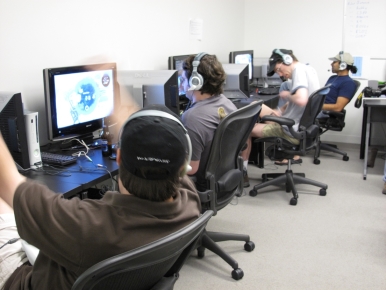Three Strategies for Curing Developer’s Block

Imagine this: Your indie studio’s newest title, Dream Game, is a surprise hit! As accolades pour in, sales climb and climb, and your head seems to be wrapped in a shimmering fog of pride and disbelief. Your baby, the dream project you poured yourself into for the last few years, is an unquestionable success.
Fast forward ten years later. The publisher calls yet another concept meeting about Dream Game 9, even though Dream Game 7 just hit the shelves two weeks ago – not to mention you’re behind schedule on Dream Game Party for handhelds, Dream Game Tactics XL for mobile, and that damn Dream Game CCG that you’ve been trying to avoid. You wearily pencil in the meeting, thinking, “If only I could start over on something new, I wouldn’t have to work on the same games anymore!”
When did this happen? When did your dream game become something you’d do anything to get away from?
In any creative hit-driven industry, managing risk is a critical task. Most of the time, the safest project is the one most likely to succeed; yet ideas that don’t stray far from the pack tend to wear everyone out involved in the product lifecycle in the long term – from the creative directors to the line developers, QA testers and even the audience.
Luckily, there are techniques that can help with managing developer’s block, grouped under three main strategies: Finding fresh blood, re-invigorating yourself, and delegating with trust.
Finding Fresh Blood
When your team’s been slogging away on a project for too long, it’s easy to lose sight of the original vision you had at the start, or even maintain the same level of enthusiasm all the way through. Fortunately there’s a secret weapon to help counter this, and it’s probably something you’re already doing: playtesting.

Exposing your game to new players can give you a rejuvenating kick right in the inspiration when you see how new players actually react to the game, especially when you’ve been making significant progress behind closed doors. If you can structure playtests to make it as exciting for your testers as possible, they’ll respond with contagious enthusiasm that could spread to the rest of the dev team.
The next step is just as logical – bringing on new team members, whether they’re interns, industry newbies or veterans. As long as your team configuration is structured to encourage and manage new ideas, adding a new voice to the project can do wonders for assessing the current state of the game for new possibilities.
Re-invigorating Yourself
Recruiting new people and ideas can definitely be helpful, but don’t underestimate your own capabilities. If you’re trudging through a bad case of developer’s block, it might be time to ask yourself some hard questions. Are you getting stuck in a rut? Is your current project starting to bore you, even though you couldn’t wait to get into the office a few months ago? If this is the case, you might be due for an infusion of inspiration.
A great way to manage this is to seek out new activities and experiences, ideally beyond your comfort zone. The strange, heightened sensation of being in a completely new situation with no pre-formed ideas of how to act or what to do can help jolt your thought process out of its rut, opening you to new ways of looking at the same problems you’ve been dealing with for months.

It’s impossible to say where inspiration can come from – Will Wright drew inspiration to create The Sims in part from reading a book about architecture; Cliff Bleszinski credits Gears of War’s “destroyed beauty” aesthetic from a trip to Europe, and parts of its gameplay from playing paintball. Live a little outside the office and you’ll be amazed at what it does for your project.
Delegating with Trust
If finding new voices and searching for inspiration doesn’t work, there’s a third option that might. If all else fails, or if circumstances prevent you from continuing to work on the game, recruiting another studio to take the reins is a viable option. Fortunately, there are two recent high-profile examples of this we can examine: 343 Industries’ Halo 4 and Kojima Productions and Platinum Games’ Metal Gear Rising: Revengeance.
Taking over for Bungie as the steward of the Halo franchise was an incredible challenge for 343. If they succeeded, their reward would largely be anonymous to their largest audience segment of casual FPS fans. If they failed, they would go down in history as the team that ruined Halo. Luckily, by all accounts they succeeded, and in no small part to their ability to look at the IP through new eyes.
While the Halo games have gradually perfected their formula over the last decade with gameplay tweaks, new multiplayer modes and a (debatably confusing) multitude of story threads, one key element had all but been abandoned after the first title: a sense of wonder, from when everything about Halo was new. Fighting the Covenant for the first time, driving the Warthog, exploring the wide-open battlefields, encountering cryptic Forerunner relics, battling the Flood – the first game packed in moment after moment of these brand new experiences, and a generation of fans was born.

Sure, later games saw advances in graphics, online play, ragdoll animations and player abilities, but none of them managed to recapture the sense of awe that permeated the first game. 343 is to be commended for identifying this as a key pillar of the franchise worth revisiting, and it’s not unreasonable to see why it took a brand-new studio to make it a reality.
Metal Gear Rising is another story. The project’s troubled development history wasn’t well known until recently, but luckily the game has managed to overcome its rocky path to release. Nearly cancelled because Kojima’s team simply couldn’t produce the fast action gameplay required, it was only when they entrusted Platinum Games with handling development duties could the project move forward.
While Kojima’s team is one of the top development houses in the industry, they were smart enough to realize that the project was not playing to their strengths, and utilized their studio relationships to delegate actual development of the game, trusting Platinum to do what they do best, to critically acclaimed results.
Diversity of Experience: The Renewable Creativity Resources
There’s a burgeoning movement happening in the industry for more diversity. Whether it’s encouraging more women, transgendered developers or ethnic minorities to start making games, this is an excellent trend and should be encouraged whole-heartedly by any gamer or game maker who values innovative, new experiences.
Look at it this way – are you satisfied with the variety of games available today? If you answered yes, and you’re aware that the industry is still dominated by straight white males, doesn’t that make you curious about what new kinds of games we’d have if we had more varied points of view contributing?
This industry of ours is an amazing thing. Let’s make sure it can continue fostering creative expression, encouraging newcomers and exploring new realms of what’s possible for the next generation, and for the one after that.
And like most things worth doing, it all starts with you.
